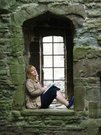Harbottle Castle, Northumberland
Location | 10 miles W of Rothbury |
Road | Off B6344, A697 |
SatNav | NE65 7 |
Harbottle Castle is a ruinous castle situated at the end of the village of Harbottle, overlooking the River Coquet. It is believed that the mound on which the keep stands was a site used by the ancient Britons and that in Saxon times was a stronghold on the site held by Mildred, son of Ackman.
The present castle was built in the mid twelfth century. The motte is over forty feet high and is surrounded by a ditch 6 feet deep. The outer bailey was also surrounded by a deep ditch over 30 feet deep internally and more than ten feet externally. Parts of the curtain wall still survive along with extensive earthworks.
The great Lords of Coquetdale and Redesdale were the Umfraville family. Relatives of William the Conqueror, he awarded them large swathes of Northumbria to defend against all coming enemies of England.
The Umfraville's ruled their little 'principality' with almost Royal powers from one of only two castles allowed, by Henry II, to be built on private land. Odinel D'Umfraville erected a huge octagonal motte and bailey fortress at Harbottle in order to help the king keep out the Scots.
There is a car park at Harbottle with access to the castle via a shortwalk. Set in stunning rolling countryside, the remoteness and surrounding landscape when you get there is very much part of its special appeal.
This is not a castle of massive curtain walls and battlements, but of earthworks and ruined stonework, with only sheep now keeping guard over this fabulous find.
A climb to the top to explore the motte is where you can really appreciate the beauty of the place, with the ruined stumps of stonework set against the surrounding landscape which is stunning, with nothing but the birds and rustle of the leaves to break the tranquility.
Like many old remote ruins, it is the surrounding landscape that makes the experience so special, and Harbottle is a good example of this.
~ History ~
1160 - The timber castle of Harbottle is contructed by the powerful Umfraville family at the request of King Henry II on the land awarded to them following the Norman Conquest as defence against the Scots.
1173 - The castle is taken by the Scots and retained for the next twelve months.
1200 - The castle is rebuilt in stone.
1296 - The castle is again besieged but this time by a force of some 40,000 men under the command of Robert de Ros. Despite this enormous force the garrison withstand the siege.
1318 - Robert the Bruce captures the castle.
1336 - The castle is restored.
1351 - A survey of the castle records it as being ruinous.
1400 - The caste is once more made defensible.
1436 - The castle passes into the hands of the Tailleboys family and is used as the residence of the Warden of the Middle Marches and as a prison.
1515 - The pregnant Queen Margaret of Scots and her second husband, the Earl of Angus arrive at the castle where she gives birth to a daughter who grows up to be the future mother of Lord Darnley, husband of Mary, Queen of Scots and father of King James VI.
1541 - Over a period of ten years the shell keep is rebuilt and extensive repairs made to the rest of the castle.
1563 - Further repairs are made.
1601 - King James I grants the castle and the manor to George Home, Lord Treasurer of Scotland. During this period the castle falls into decay and much of its masonry is removed for other buildings.
